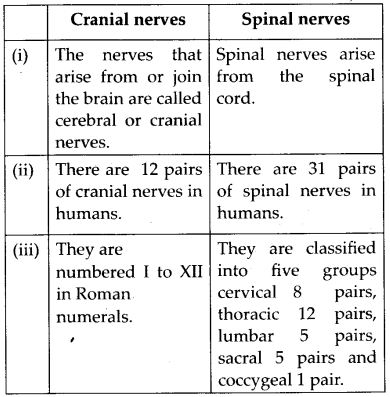Chapter 21 Neural Control and Coordination
Class 11th Biology NCERT Book Solution
NCERT Solutions For Class 11 Biology Neural Control and Coordination
NCERT TEXTBOOK QUESTIONS FROM SOLVED
1. Briefly describe the
structure of the following:
(a) Brain (b) Eye (c) Ear
Solution: (a)
Brain: The brain acts as control and command system of the body. It is
protected by skull and is covered by three meninges. It is divisible into three
main regions: forebrain, midbrain and hindbrain.
(i) Forebrain – It consists
of three regions:
(a) Olfactory lobes: These are a pair of very small, solid
club-shaped bodies which are widely separated from each
other. They are fully
covered by cerebral hemispheres.
(b) Cerebrum – It is the largest and most
complex of all the parts of human brain. A deep cleft divides the cerebrum into
right and left cerebral hemispheres, connected by myelinated fibres, the corpus
callosum.
(c) Diencephalon – It encloses a slit-like cavity, the third
ventricle. The thin roof of this cavity is known as the epithalamus, the thick
right and left sides as the thalami, and floor as the hypothalamus.
(ii)
Midbrain – It is located between thalamus/ hypothalamus of forebrain and pons of
hindbrain. Its upper surface has two pairs of rounded protrusious called corpora
quadrigemina and two bundles of fibres called crura cerebri.
(iii) Hindbrain
– It consists of:
(a) Cerebellum – The second largest part of the human brain
is the cerebellum. It consists of two lateral cerebellar hemispheres and central
worm-shaped part, the vermis. The cerebellum has its grey matter on the outside,
comprising three layers of cells and fibres. It also has Golgi cells, basket
cells and granule cells.
(b) Pons varolii – An oval mass, called the pons
varolii, lies above the medulla oblongata. It consists mainly of nerve fibres
which interconnect different regions of the brain.
(c) Medulla oblongata – It
extends from the pons varolii above and is continuous with the spinal cord
below. The mid brain, pons varolii and medulla oblongata are collectively called
brain stem.
(b) Eye: Eye is a hollow spherical structure composed of
three coats:
– Outer fibrous coat
– Middle vascular coat
– Inner
nervous coat
(i) Fibrous coat: It is thick and protects the eyeball. It has
two distinct regions – sclera and cornea. Sclera covers most of the eye ball.
The sclera or white of the eye contains many collagen fibres. Cornea is a
transparent portion that forms the anterior one – sixth of the eyeball. The
cornea is avascular (i.e., lacks blood supply).
(ii)Vascular coat: It
comprises of 3 regions : choroid, iris, ciliary body.
(a) Choroid : It lies
adjacent to sclera and contains numerous blood vessels and pigmented cells.
(b) Iris: The iris is a circular muscular diaphragm containing the pigment
giving eye its colour. It extends from the ciliary body across the eyeball
in front of the lens. It 2. has an opening in the centre called the pupil.
It
contains two types of smooth muscles, circular muscles (sphincters) and radial
muscles (dilators), of ectodermal origin.
(c) Ciliary body: Behind the
peripheral margin of the iris, the vascular coat is thickened to form the
ciliary body. It is composed of the ciliary muscles and the ciliary
processes.
(iii) Nervous coat: It consists of retina which is neural and
sensory layer of an eye ball. It consists of three layers; ganglion cells,
bipolar cells and photoreceptor cells (rods and cones).
Lens: It is a
transparent, biconvex, elastic structure that bends light waves as they pass
through its surface. It is composed of epithelial cells that have large amounts
of clear cytoplasm in the form of fibres.
Chambers of eyeball: The lens,
suspensory ligament and ciliary body divide the eye into an anterior aqueous
chamber and a posterior vitreous chamber which are filled with aqueous humour
and vitreous humour respectively.
(c) Ear: There are three portions in an ear:
(i) External
ear: It further has 2 regions: pinna and external auditory canal or meatus.
(a) Pinna: The pinna is a projecting elastic cartilage covered with skin. Its
most prominent outer ridge is called the helix. The lobule is the soft pliable
part at its lower end composed of fibrous and adipose tissue richly supplied
with blood capillaries. It is sensitive as well as effective in collecting sound
waves.
(b) External auditory canal: It is an S-shaped tube leading inward
from the pinna. It is a tubular passage supported by cartilage in its exterior
part and by bone in its interior part.
(ii) Middle ear: It consists of 3
small bones called ear ossicles – malleus, incus and stapes, which are attached
to one another and increase efficiency of transmission of sound waves to inner
ear.
(iii) Internal ear: It consists of bony and
2. Compare the
following:
(a) Central neural system (CNS) and Peripheral neural system
(PNS).
(b)
Resting potential and action potential.
(c) Choroid and retina.
Solution: (a)
CNS: It lies along the mid-dorsal axis of the body. It is a hollow, dorsally
placed structure and comprises of brain and spinal cord. It is a centre of
information processing and control.
PNS: Nerves arising from the central
nervous system constitute the peripheral nervous system. It carries information
to and from the CNS. It includes spinal nerves and cranial nerves.
(b)
Resting potential: Outside the plasma membrane of a nerve fibre is the
extracellular fluid which is positively charged with respect to the cell
contents inside the plasma membrane. A resting nerve fibre shows a potential
difference between inside and outside of this plasma membrane. This difference
in the electrical charges across the plasma membrane is called the ‘resting
potential’. A membrane with resting potential across it, is said to be
electrically polarized. Action potential : Action potential is another name
of nerve impulse. The contents inside a cell at the excited state becomes
positively charged with respect to extracellular fluid outside it. This change
in polarity across the plasma membrane is known as an action potential. The
membrane with reversed polarity across it is said to be depolarized.
(c)
Choroid: Choroid lies adjacent to the sclera and contains numerous blood vessels
that supply nutrients and oxygen to the other tissues especially of retina. It
contains abundant pigment cells and is dark brown in colour.
Retina: It is
the neural and sensory layer of the eye ball. It is a very delicate coat and
lines the whole of the vascular coat. Its external surface is in contact with
the choroid and its internal surface with vitreous humour. It contains ganglion
cells, bipolar cells and photoreceptor cells. membranous labyrinth. Membranous
labyrinth consists of three semicircular ducts, utricle, saccule and
cochlea.
3. Explain the following
processes:
(a) Polarisation of the membrane of a nerve fibre.
(b) Depolarisation of the membrane of
a nerve fibre.
(c) Conduction of a nerve impulse
along a nerve fibre.
(d) Transmission of a nerve impulse
across a chemical
synapse.
Solution: (a) Polarisation of
the membrane of a nerve fibre : In the resting (not conducting impulse) nerve
fibre the plasma membrane separates two solution of different chemical
composition but having approximately the same total number of ions. In the
external medium (tissue fluid), sodium ions (Na+) and Cl–
ions predominate, whereas within the fibre (intracellular fluid) potassium ions
(K+) predominate. The differential flow of the positively
charged ions and the inability of the negatively charged organic (protein) ions
within the nerve fibre to pass out cause an increasing positive charge on the
outside of the membrane and negative charge on the inside of the membrane. This
makes the membrane of the resting nerve fibre polarized, extracellular fluid
outside being electropositive (positively charged) with respect to the cell
contents inside it.
(b) Depolarisation of the membrane of a nerve fibre:
During depolarisation, the activation gates of Na channels open, and the K
channels remain closed. Na+ rush into the axon. Entry of sodium ions
leads to depolarisation (reversal of polarity) of the nerve membrane, so that
the nerve fibre contents become electropositive with respect to the
extracellular fluid.
(c) Conduction of a nerve impulse along a nerve fibre:
Nervous system transmits information as a series of nerve impulses. A nerve
impulse is the movement of an action potential as a wave through a nerve fibre.
Action potentials are propagated, that is, self-generated along the axon. The
events that set up an action potential at one spot on the nerve fibre also
transmit it along the entire length of the nerve fibre. The action potential
then moves to the neighbouring region of the nerve fibre till it covers the
whole length of the fibre.
(d) Transmission of a nerve impulse across a
chemical synapse: At a chemical synapse, the membranes of the pre- and post-
synaptic neurons are separated by a fluid- filled space called synaptic cleft.
Chemicals called neurotransmitters are involved in the transmission of impulses
at these synapses. The axon terminals contain vesicles filled with these
neurotransmitters. When an impulse (action potential) arrives at the axon
terminal, it stimulates the movement of the synaptic vesicles towards the
membrane where they fuse with the plasma membrane and burst to release their
neurotransmitters in the synaptic cleft. The released neurotransmitters bind to
their specific receptors, present on the post- synaptic membrane. This binding
opens ion channels allowing the entry of ions which can generate a new potential
in the post-synaptic neuron. The new potential developed may be either
excitatory or inhibitory.
4. Draw labelled diagrams of
the following:
(a) Neuron (b)
Brain
(c)
Eye (d) Ear
Solution: (a)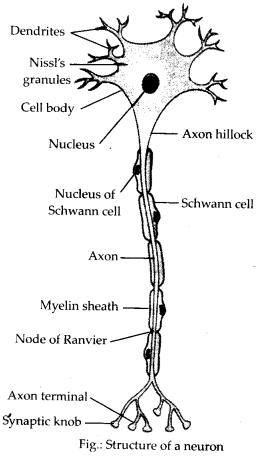
(b)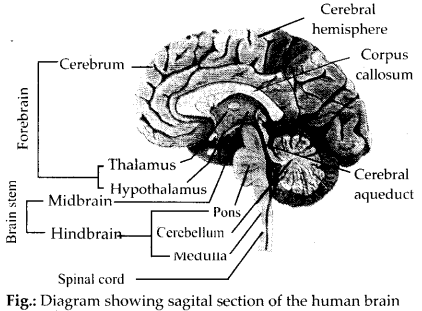
(c)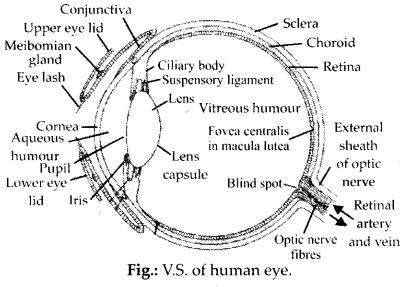
(d)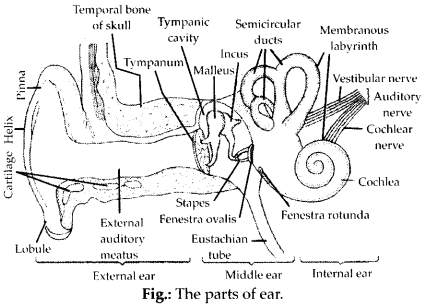
5. Write short notes on the
following:
(a) Neural coordination (b) Forebrain
(c) Midbrain
(d) Hindbrain
(e) Retina
(f) Ear ossicles
(g) Cochlea
(h) Organ of Corti
(i) Synapse
Solution: (a) Neural
coordination : When higher animals respond to various stimuli, each response to
a specific stimulus generally involves many organs (parts) of their bodies.
Therefore, it is necessary that all the concerned organs (parts) of the body
should work in a systematic manner to produce the response. The working together
of various organs (parts) of the body of multicelullar organism in a proper
manner to complement the functions of each other is called coordination. This is
achieved by three overlapping processes of nervous system-sensory input,
integration and motor output.
(b) Forebrain: It consists of: Olfactory lobes,
the paired structures concerned with the sense of smell. Cerebrum which is the
largest and most complex of all the parts of the human brain. It is divided by a
cleft into left and right cerebral hemispheres which are connected by a large
bundle of myelinated fibres the. corpus callosum. The outer cover of cerebral
hemisphere is called cerebral cortex. It consists of sensory and motor areas.
Hypothalamus region of forebrain contains centres which control body
temperature, hunger and also contains group of neurosecretory cells.
(c)
Midbrain: The midbrain is located between the thalamus/hypothalamus of the
forebrain and pons of the hindbrain. A canal called the cerebral aqueduct
passess through the midbrain. The dorsal portion of the midbrain consists mainly
of four round swellings (lobes) called corpora quadrigemina. Midbrain and
hindbrain form the brain stem.
(d) Hindbrain: The hindbrain comprises pons,
cerebellum and medulla. Pons consists of fibre tracts that interconnect
different regions of the brain. Cerebellum has very convoluted surface in order
to provide the additional space of many more neurons. The medulla of the brain
is connected to the spinal cord. The medulla contains centres which control
respiration, cardiovascular reflexes and gastric secretions.
(e) Retina:
Retina is the inner layer of an eye and it contains three layers of cells-from
inside to outside – ganglion cells, bipolar cells and photoreceptor cells. There
are two types of photoreceptor cells, namely, rods and cones. These cells
contain the light-sensitive proteins called the photopigments. The daylight
(photopic) vision and colour vision are functions of cones and the twilight
(scotopic) vision is the function of the rods. The rods contain a purplish-red
protein called the rhodopsin or visual purple, which contains a derivative of
Vitamin A. In the human eye, there are three types of cones which possess their
own characteristic photopigments that respond to red, green and blue lights. The
sensations of different colours are produced by various combinations of these
cones and their photopigments. When these cones are stimulated equally, a
sensation of white light is produced.
(f) Ear ossicles : There is a small
flexible chain of three small bones called as ear ossicles – the malleus (hammer
shaped), the incus (anvil shaped) and the stapes (stirrup shaped) in the middle
ear. Malleus is attached to the tympanic membrane on one side and incus on the
other side. Incus in turn is connected with the stapes. Malleus is the largest
ossicle, however stapes is the smallest ossicle.
(g) Cochlea : It is the main
hearing organ which is connected with saccule. It is a spirally coiled tube that
resembles a snail shell in appearance. It tapers from a broad base to an almost
pointed apex.
(h) Organ of Corti: It is a structure located on the basilar
membrane which contains hair cells that act as auditory receptors. The hair
cells are present in rows on the internal side of the organ of Corti.
(i)
Synapse : It is the junction between the axon of one neuron and the dendrite or
cyton of another neuron for transmission of nerve impulse.
6. Give a brief account
of
(a)
Mechanism of synaptic transmission.
(b) Mechanism of vision.
(c) Mechanism of hearing.
Solution: (a)
Mechanism of synaptic transmission: Refer answer 3 (d)
(a) Mechanism of
vision: The light rays in visible wavelength focused on the retina through the
cornea and lens generate potentials (impulses) in rods and cones. Light
induces
dissociation of the retinal from opsin resulting in changes in the
structure of the opsin. This causes membrane permeability changes. As a result,
potential differences are generated in the photoreceptor cells. This produces a
signal that generates action potentials in the ganglion cells through the
bipolar cells. These action potentials (impulses) are transmitted by the optic
nerves to the visual cortex area of the brain, where the neural impulses are
analysed and the image formed on the retina is recognised based on earlier
memory and experience.
(b) Mechanism of hearing : The external ear receives
sound waves and directs them to the ear drum. The ear drum vibrates in response
to the sound waves and these vibrations are transmitted through the ear ossicles
(malleus, incus and stapes) to the oval window. The vibrations are passed
through the oval window on to the fluid of the cochlea, where they generate
waves in the lymphs. The waves in the lymphs induce a ripple in the basilar
membrane. These movements of the basilar membrane bend the hair cells, pressing
them against the tectorial membrane. As a result, nerve impulses are generated
in the associated afferent neurons. These impulses are transmitted by the
afferent fibres via auditory nerves to the auditory cortex of the brain, where
the impulses are analysed and the sound is recognised.
7. Answer
briefly.
(a)
How do you perceive the colour of an object?
(b) Which part of our body helps us in maintaining the body
balance?
(c)
How does the eye regulate the amount of light that falls on the
retina?
Solution: (a)In humans, colour
vision results from the activity of cone cells, a type of photoreceptor cells.
In the human eye, there are three types of cones which possess their own
characteristic photopigments that respond to red, green and blue lights. The
sensations of different colours are produced by various combinations of these
cones and their photopigments. When these cones are stimulated equally,
sensation of white light is produced. Yellow light, for instance, stimulates
green’and red cones approximately to equal extent, and this is interpreted by
the brain as yellow colour.
(b) Ears (cristae and maculae present in internal
ears).
(c) The iris contains two sets of smooth muscles – sphincters and
dilators. These muscles regulate the amount of light entering the eyeball by
varying the size of pupil. Contraction of sphincter muscles makes the pupil
smaller in bright light so that less light enters the eye. Contraction of
dilator muscles widens the pupil in dim light so that more light goes in eye to
fall on retina.
8. Explain the
following.
(a) Role of Na+ in the generation of action
potential.
(b) Mechanism of generation of light-induced impulse in the
retina.
(c)
Mechanism through which a sound produces a nerve impulse in the inner
ear.
Solution: (a) The action potential
is largely determined by Na+ ions. The action potential results from
the following sequential events
(i) Disturbance caused to the membrane of a
nerve fibre by a stimulus results in leakage of Na+ into the
nerve fibre.
(ii) Entry of Na+ lowers the trans-membrane potential
difference.
(iii) Decrease in potential difference makes the membrane more
permeable to Na+ than to K+ ions so that more
Na+ enter the fibre than K+ leave it.
(iv) Accumulation
of Na+ in the nerve fibre initiates depolarisation (action
potential), making the axonic contents positively charged relative to the
extracellular fluid.
(v) With continued addition of Na+ the
potential reaches zero and then plus 40-50 millivolts. This is the peak of
action potential.
(vi) Permeability of a depolarised membrane to
Na+ then rapidly drops, there are now as many Na+ on the
inside of the membrane as on the outside.
(b) Refer answer 6 (b)
(c) Refer
answer 6 (c)
9. Differentiate
between
(a)
Myelinated and non-myelinated axons
(b) Dendrites and axons
(c) Rods and cones
(d) Thalamus and
Hypothalamus
(e) Cerebrum and
Cerebellum
Solution: (a) Differences
between myelinated and non-myelinated axons are as follows: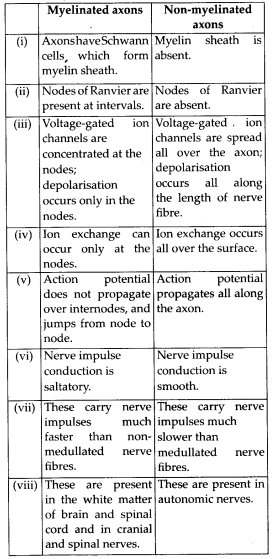
(b) Axon and dendrites can be differentiated as
follows: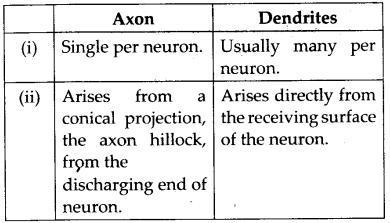
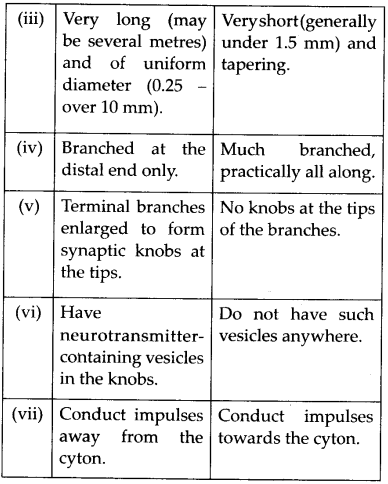
(c) The differences between rods and cones are as
follows: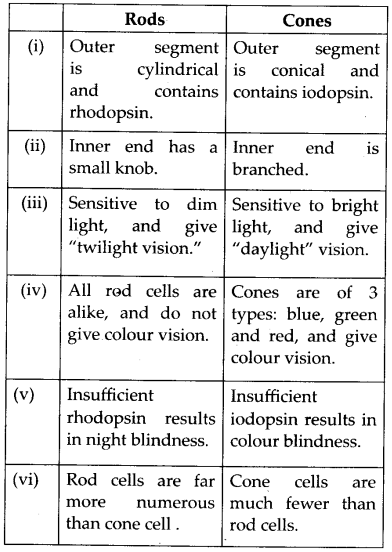
(d) Thalamus and hypothalamus can be differentiated as
follows: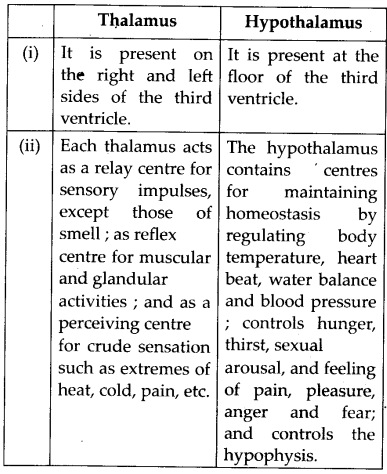
(e) Cerebrum and cerebellum can be differentiated as
follows: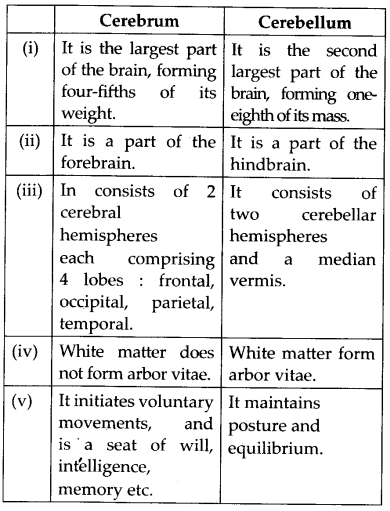
10. Answer the
following.
(a) Which part of the ear determines the pitch ofa
sound?
(b)
Which part of the human brain is the most developed?
(c) Which part of our central neural
system acts as a master
clock?
Solution: (a) The receptor cells
in the organ of Corti (Internal ear).
(b) Cerebrum (cerebral
hemispheres).
(c) Pineal gland present in diencephalon of forebrain acts as a
master clock, which maintains biological rhythm.
11. The region of the
vertebrate eye, where the optic nerve passes out of the retina, is called
the
(a)
fovea (b) iris
(c) blind spot (d) optic
chiasma
Solution: (c) blind spot
12. Distinguish
between
(a)
Afferent neurons and efferent neurons
(b) Impulse conduction in myelinated nerve fibre and unmyelinated nerve
fibre
(c)
Aqueous humour and vitreous humour
(d) Blind spot and yellow spot
(e) Cranial nerves and spinal
nerves
Solution: (a)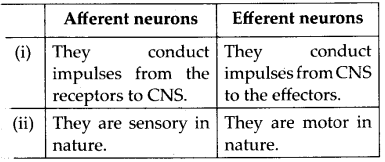
(b) Refer answer 9(a)
(c)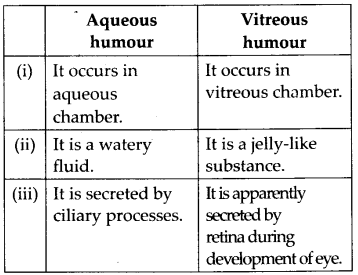

(d)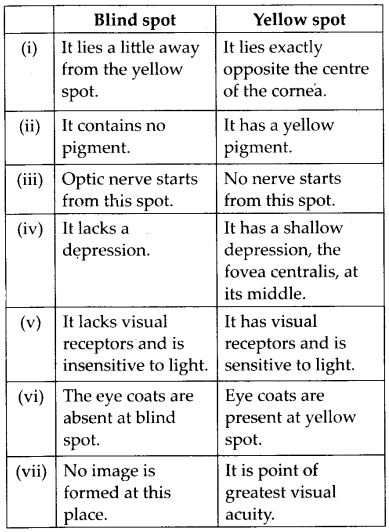
(e)